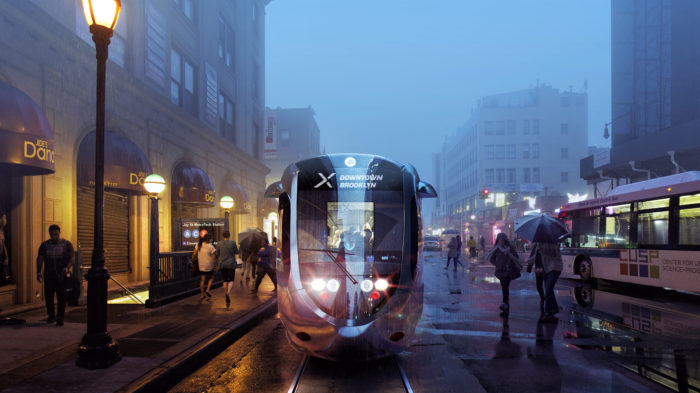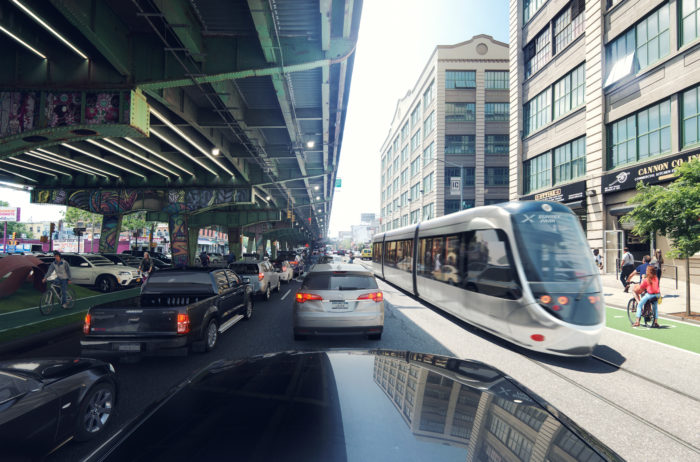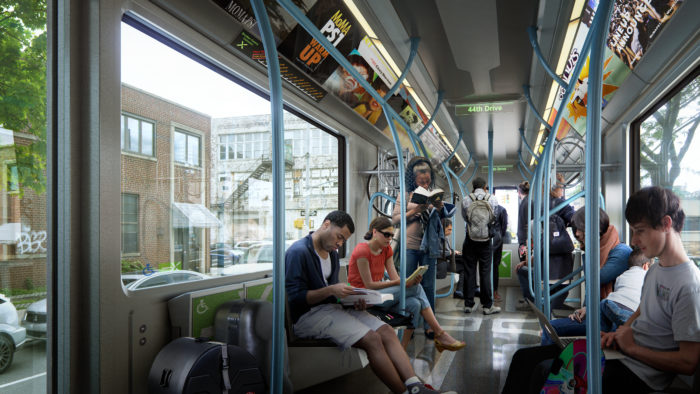Why the BQX Steetcar Will Bring a Better City
While a $1.7 billion project deserves to be scrutinized, let's not forget the bigger picture: an economic boost for all
A rendering of the proposed BQX streetcar, shown in Downtown Brooklyn
Does the Brooklyn-Queens waterfront region need its own streetcar? The announcement of the Brooklyn-Queens Connector (BQX) by Mayor de Blasio in 2016 has trigged passionate debate on the merits of the 17-mile, $1.7 billion project. Rightly so: an undertaking this complicated–and a vision this grand–are worthy of thorough discussion. However, I want to highlight three things that could help put this initiative in perspective, since I fear at times the block-by-block wrangling over the details of this project is eclipsing the bigger picture.
First, the BQX is not just some shiny new toy. The larger purpose is economic development, the biggest such proposal for Brooklyn and Queens in a generation. A valid historical comparison is the construction of the East River bridges in the 19th and 20th centuries, which unlocked opportunity for millions of New Yorkers by providing East-West connections that helped to solidify the economic ties between the city’s population centers. The BQX would be the comprehensive transit solution we need to unite the Brooklyn-Queens waterfront, creating a North-South spine that will lay the foundation for a future with more jobs, affordable housing, and office space.
Second, we are in the midst of unprecedented growth in Brooklyn and Queens. If you look at demographic data, as well as employment and residential growth trends, what emerges is all the makings of a labor force and creative-talent pool that no longer needs to commute to Manhattan to pursue their enterprises. These drivers of the new economy are already feeling at home in neighborhoods like the Brooklyn Tech Triangle and Long Island City. Just wait until the BQX unites these employment hubs and makes them accessible for the residents of Red Hook and Ravenswood.

The BQX streetcar zipping past Industry City along Third Avenue, in a rendering
Finally, an idea of this magnitude inevitably runs into all manner of obstacles and competing agendas. Navigating them takes courage and vision. Mayor Bill de Blasio and Deputy Mayor Alicia Glen should be applauded for having the guts to undertake this effort. Vocal detractors will tell you this project cannot and should not be done. They fail to point to the positive effects of the streetcar and light-rail renaissance around this country and all over the world.
Critics cite a single leaked internal memo–in draft form–about cost projections. OK, that’s part of the discussion too, but critics neglect to mention that these figures do not take into account the myriad solutions that may be explored, which range from streamlining construction methods to lining up more sources of capital. Contrary to the innuendo this memo launched, what the document actually demonstrates is the presence of due diligence being undertaken by city officials. This should provide all of us with comfort that the project is getting the scrutiny it deserves.

Inside a car of the proposed BQX, as shown in a rendering
The argument of detractors that transit dollars are better spent elsewhere is sleight of hand. Some say that new bus lines would be less glamorous and more effective, but the point of a streetcar is having a dedicated route and getting you faster from borough to borough. Some say there are more pressing projects that could use an immediate cash infusion, like long-called-for proposals for the Utica Avenue subway extension in Brooklyn. Yes, that’s a worthy project too. But what’s compelling about the north-south corridor connecting Brooklyn and Queens is that it’s one of the few routes where potential growth is sure to cover the cost of construction. This is what will allow it to be financed, without state or federal funding. These projects don’t need to impose either/or decisions on us. We should use capital spending to address pressing transit needs and we should look for opportunities to use creative financing tools on innovative projects like the BQX.
In the early 20th century, when the 7 subway line was first built to connect Queens to Manhattan, it was surrounded by largely vacant land. Today, it is one of the busiest subways in New York City and its presence paved the way for countless job and housing growth in areas like Flushing, Queens. While today’s Brooklyn-Queens waterfront is not in danger of neglect, it is plausible that left to market forces, the future of waterfront development in Brooklyn and Queens will be almost exclusively luxury housing, a terrible urban condition. The streetscape would be dominated by cars, taxis, Ubers, and private shuttles–and haunted by missed opportunities for job growth in industrial business zones like the booming southwest Brooklyn region.
With this proposal, the city has the opportunity to help create a more equitable community. Infrastructure like the BQX can connect long-isolated residents to job and housing opportunities. This is a big idea that should be applauded, one that lays the groundwork for growth for decades to come. Mayor de Blasio may face some heat for it today, but our children and grandchildren will thank him for it in the 22nd century.
Editor’s note: the writer is on the board of directors of the Friends of the Brooklyn Queens Connector.













